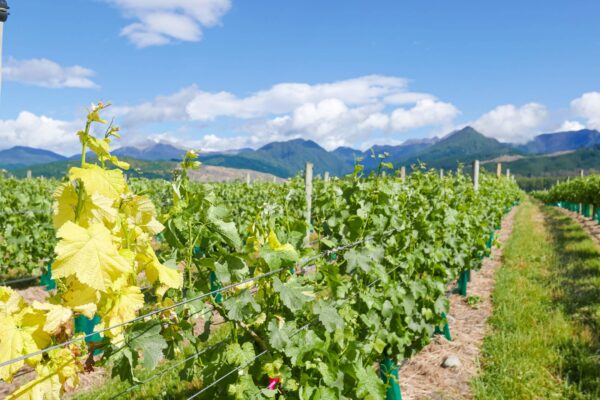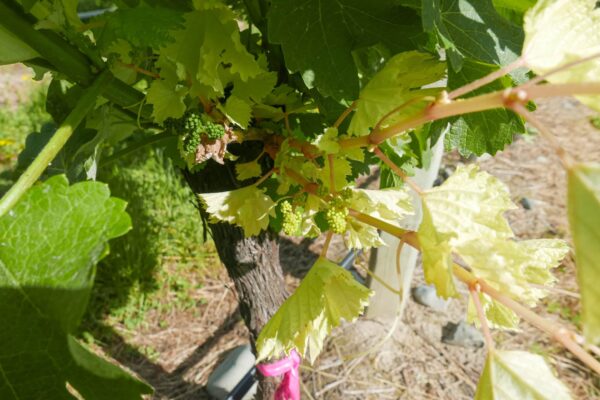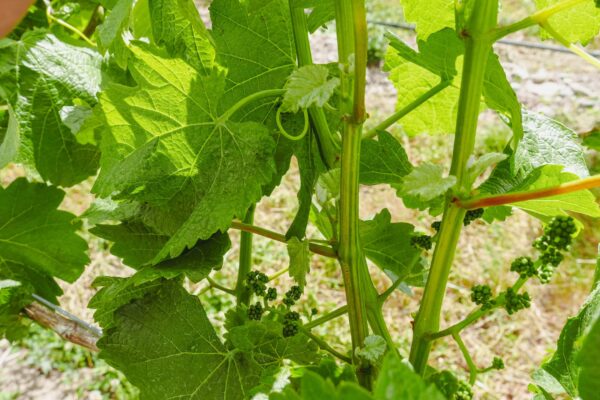There are two factors that influence how a vine grows: its genetics and its environment. The Bragato Research Institute’s Grapevine Improvement Programme investigates the genetic side, to learn more about resilience and new clones naturally occurring in our vineyards.
In New Zealand, every grapevine clone we currently grow originated in a vineyard, often because someone noticed something odd and collected it. BRI is collecting odd vines or ‘bud sports’ to add to the industry’s growing collection of grapevine diversity.
Monitoring unusual vines
Carla Kissane-Rako is a Technical Viticulturist at Delegat’s Wairau Valley vineyards which span 550 hectares next to the Wairau River.
Despite the vast number of vines under her care, Carla knows every row and there are a few vines that have caught her eye this season. Three vines have developed variegated canes that produce yellow-green leaves, stripey stems, inflorescences and even stripey fruit. This is the first year two of them have displayed this odd trait.
The variegation doesn’t seem related to age, with one vine 20 years old, one 11 years old, and one only 3 years old. “The youngest of the three has displayed variegated leaves and fruit since it was first planted”, says Carla.
In late November when the foliage is starting to grow, the spires of yellow leaves are easily spotted amongst the sea of green. When she first notices an unusual vine, Carla ties a pink tie around the trunk, makes a record and keeps an eye on it as it grows over several weeks. If the ‘odd vines’ continue to develop, she submits a photo to the OddVine website.
Submitting odd vines
When you submit a vine to the OddVine website, the photo alongside information such as variety, clone, and GPS location is automatically added to the New Zealand OddVine database. BRI’s Grapevine Improvement team routinely assess records that are being submitted from around the country.
“Often submitted vines are displaying traits that make the vine appear less suitable for winemaking”, says Principal Scientist Darrell Lizamore. “This doesn’t mean it’s a waste, we want anything odd – even unappealing traits can be useful for training our genetic selection. In cases where it might be the result of a disease or a nutritional deficiency, our team can then notify the person who submitted the photo so they can address the issue.”
As she drives up to the main entrance of the vineyard Carla points to another vine. “I thought this vine was showing signs of trunk disease”, she says. “But it’s looked like that for three years now and hasn’t fallen to one side like I expected.” The vine’s foliage is lush despite some colouring on the leaves. She says she plans to submit it to OddVine soon.
If a submitted vine is particularly unusual or may be of value, the Grapevine Improvement team request a cutting so it can be grown under controlled conditions, observed, and genetically sequenced to validate the vine as a novel clone.
How the OddVine database is used
The OddVine database is a useful resource for research like the Sauvignon Blanc Grapevine Improvement Programme. The programme aims to increase the resilience of the New Zealand wine industry by creating 12,000 diverse variants of New Zealand Sauvignon Blanc, and then screening them to identify plants that exhibit useful traits such as improved yield, resistance to fungal infection, frost tolerance and water use efficiency, while maintaining the iconic Marlborough Sauvignon Blanc wine flavour and aroma.
This year the programme completed a highly-accurate reference genome of the Mass Select (UCD1) clone. This valuable genomic resource will now allow the team to comprehensively describe genetic differences between ‘Mass Select’ and other commercially-grown Sauvignon Blanc clones, the 12,000 new variants, as well as to characterise ‘odd vines’ like Carla’s in vineyards.
Once the most desirable traits are found amongst these clones and odd vines, the most promising vines will be trialled in commercial vineyards. At the end of the programme, the goal is for the industry will have a diverse selection of Sauvignon Blanc clones to choose from suited to their vineyard’s environment.
Get involved
If you’ve seen something unusual in your vineyard and would like to contribute to the database, please submit it to the OddVine website.






















